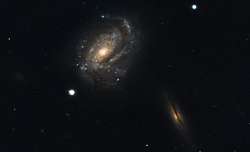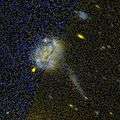NGC 877
NGC 877 is an intermediate spiral galaxy located in the constellation Aries. It is located at a distance of circa 160 million light years from Earth, which, given its apparent dimensions, means that NGC 877 is about 115,000 light years across. It was discovered by William Herschel on October 14, 1784.[3] It interacts with NGC 876.
| NGC 877 | |
|---|---|
 NGC 877 (left) and NGC 876 (right) by PanSTARRS | |
| Observation data (J2000 epoch) | |
| Constellation | Aries |
| Right ascension | 02h 17m 59.6s[1] |
| Declination | +14° 32′ 38″[1] |
| Redshift | 0.013052 ± 0.000010 [1] |
| Helio radial velocity | 3,913 ± 3 km/s[1] |
| Distance | 154 ± 25 Mly (47.1 ± 7.5 Mpc)[1] |
| Apparent magnitude (V) | 11.8 [2] |
| Characteristics | |
| Type | SAB(rs)bc [1] |
| Apparent size (V) | 2′.4 × 1′.8 [1] |
| Notable features | Luminous infrared galaxy |
| Other designations | |
| UGC 1768, CGCG 438-052, MCG +02-06-058, PGC 8775[1] | |
NGC 877 features two spiral arms with a grand design pattern and slightly disturbed morphology. When pictured in H-alpha, the arms have numerous knots and appear brighter than the nucleus.[4] The northwest part of the galaxy has higher polarised emission than the rest of the galaxy. A bar appears in radio waves.[5] The nucleus has activity that resembles that of a HII region.[6] The galaxy has been categorised as a luminous infrared galaxy, a category of galaxies associated with high star formation rate. The total infrared luminosity of the galaxy is estimated to be between 1011.04 L☉[7] and 1011.1 L☉, lying near the threshold to classify a galaxy as luminous infrared. The total star formation rate in NGC 877 is estimated to be between 20 and 53 M☉ per year.[8]
One possible supernova has been observed in NGC 877, SN 2019rn. It was discovered by the robotic sky survey ATLAS on January 12.30, 2019, using a twin 0.5m telescope system. It had apparent magnitude 18.9 on discovery.[9] The supernova was initially classified as a type II supernova with spectroscopic observations by Keck-II,[10] and further spectrographic observations categorised it as type IIb, although it could also be a cataclysmic variable or another type of variable star.[11]
NGC 877 forms a pair with the edge-on spiral galaxy NGC 876, which lies 2.1 arcminutes to the southwest. At the distance of NGC 877, this corresponds to a projected distance of 30 kpc.[4] A low surface brightness bridge connects the two galaxies.[5] NGC 870 and NGC 871 are two other nearby galaxies.[4] NGC 877 is the brightest and most massive member of a galaxy group known as the NGC 877 group or LGG 35. Other members of the group include NGC 876 and NGC 871, as well as UGC 1693, IC 1791, UGC 1773, and UGC 1817.[12] The group contains large amounts of HI gas.[13]
Gallery
 NGC 877 (left) and NGC 876 by GALEX
NGC 877 (left) and NGC 876 by GALEX View of the NGC 877 group, by Adam Block
View of the NGC 877 group, by Adam Block
References
- "NASA/IPAC Extragalactic Database". Results for NGC 877. Retrieved 2016-01-18.
- "Revised NGC Data for NGC 877". spider.seds.org. Retrieved 25 November 2018.
- Seligman, Courtney. "NGC 877 (= PGC 8775)". Celestial Atlas. Retrieved 19 November 2018.
- Hattori, T.; Yoshida, M.; Ohtani, H.; Sugai, H.; Ishigaki, T.; Sasaki, M.; Hayashi, T.; Ozaki, S.; Ishii, M.; Kawai, A. (February 2004). "A Study of the Distribution of Star-forming Regions in Luminous Infrared Galaxies by Means of H Imaging Observations". The Astronomical Journal. 127 (2): 736–757. arXiv:astro-ph/0311179. Bibcode:2004AJ....127..736H. doi:10.1086/381060.
- Drzazga, R. T.; Chyży, K. T.; Jurusik, W.; Wiórkiewicz, K. (19 August 2011). "Magnetic field evolution in interacting galaxies". Astronomy & Astrophysics. 533: A22. arXiv:1107.3280. Bibcode:2011A&A...533A..22D. doi:10.1051/0004-6361/201016092.
- Ho, Luis C.; Filippenko, Alexei V.; Sargent, Wallace L. W. (October 1997). "A Search for "Dwarf Seyfert Nuclei. III. Spectroscopic Parameters and Properties of the Host Galaxies". The Astrophysical Journal Supplement Series. 112 (2): 315–390. arXiv:astro-ph/9704107. Bibcode:1997ApJS..112..315H. doi:10.1086/313041.
- Sanders, D. B.; Mazzarella, J. M.; Kim, D.-C.; Surace, J. A.; Soifer, B. T. (October 2003). "The IRAS Revised Bright Galaxy Sample". The Astronomical Journal. 126 (4): 1607–1664. arXiv:astro-ph/0306263. Bibcode:2003AJ....126.1607S. doi:10.1086/376841.
- Pereira-Santaella, Miguel; Alonso-Herrero, Almudena; Colina, Luis; Miralles-Caballero, Daniel; Pérez-González, Pablo G.; Arribas, Santiago; Bellocchi, Enrica; Cazzoli, Sara; Díaz-Santos, Tanio; López, Javier Piqueras (6 May 2015). "Star-formation histories of local luminous infrared galaxies". Astronomy & Astrophysics. 577: A78. arXiv:1502.07965. Bibcode:2015A&A...577A..78P. doi:10.1051/0004-6361/201425359.
- "ATel #12384: ATLAS19bdu (AT2019rn): discovery of a candidate SN in NGC 0877 (47 Mpc)". ATel. 13 January 2019.
- "ATel #12388: Spectroscopic classification of SN2019rn as a Type II supernova with Keck-II". ATel. 14 January 2019.
- "ATel #12391: SCAT classification of optical transients". ATel. 15 January 2019.
- Garcia, A. M. (1993). "General study of group membership. II - Determination of nearby groups". Astronomy and Astrophysics Supplement Series. 100 (1): 47–90. Bibcode:1993A&AS..100...47G. ISSN 0365-0138.
- Lee-Waddell, K.; Spekkens, K.; Cuillandre, J.-C.; Cannon, J.; Haynes, M. P.; Sick, J.; Chandra, P.; Patra, N.; Stierwalt, S.; Giovanelli, R. (1 October 2014). "An extremely optically dim tidal feature in the gas-rich interacting galaxy group NGC 871/NGC 876/NGC 877". Monthly Notices of the Royal Astronomical Society. 443 (4): 3601–3611. arXiv:1407.1732. Bibcode:2014MNRAS.443.3601L. doi:10.1093/mnras/stu1345.
External links
| Wikimedia Commons has media related to NGC 877. |
- NGC 877 on WikiSky: DSS2, SDSS, GALEX, IRAS, Hydrogen α, X-Ray, Astrophoto, Sky Map, Articles and images
- NGC 877 on SIMBAD